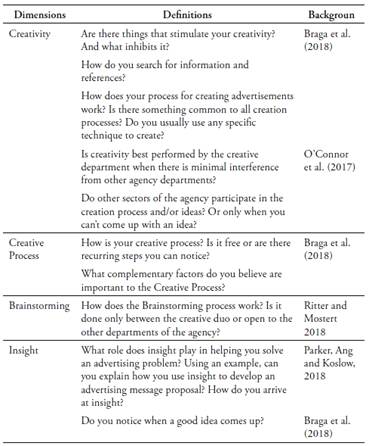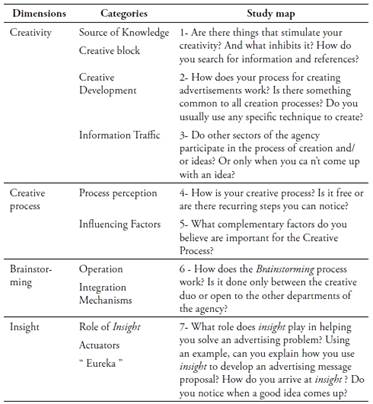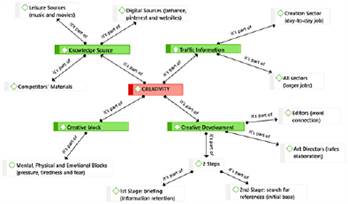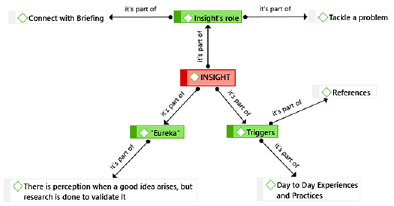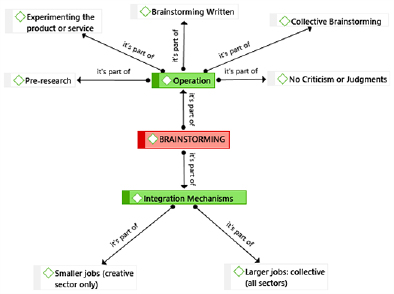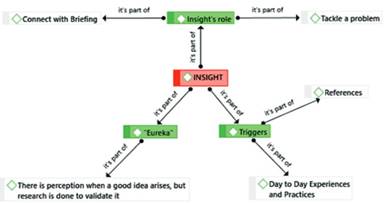This research came from questions about moments of creative insufficiency in the development of jobs, in the most different aspects - techniques, strategies and ideations based on creativity, its concepts and conceptions, its use in advertising and its correlations between the creative process, brainstorming and insight. To this end, the aim was to explain this research through discussion with ascending authors on the subject, such as Goswami (2012), Ostrower (2007), Predebon (2003), Depexe (2008), Ciglioni Jr (2009), Nicolau (2014), Sattin (2014), and contemporary researchers such as Braga, et al. (2018), O’Connor et al. (2018), Ritter and Mostert (2018), Mbah et al. (2018), Parker et al. (2018), Pinheiro et al. (2018), Modig and Dahlen (2020) and West et al. (2019) order by year, such that they were indispensable for the progression of the theoretical review and dimensions of this work.
In addition to various factors such as imagination, spontaneity, intuition and other related words, creatives identify usual steps in the practice of creating, but they do not follow them consciously. In addition, the short deadlines for approval of campaigns cause exhaustion, as they demand a lot of effort; therefore, they greatly limit creativity (Braga et al., 2018).
To get good publicity, it depends on how the professional understanding of everyone is and on the ideation process to be worked in a network, that is, creativity in agencies should not be an isolated process, where each department works in its own corner, for on the contrary, the ideation process becomes integrative, as ideas flow better, and their sharing is what makes this possible (O’Connor, et al., 2018).
According to Ritter and Mostert (2018) there are four techniques to help generate creative ideas in the brainstorming process. (i) Silence - is based on not imposing rules, criticisms, or judgments during the process. (ii) Evolution - based on transformation, in which changes in forms can be included, that is, it aims at how an idea and/or product can be evolved in another form. (iii) Random Connections - aim at couplings between concepts and unconnected objects and stimulate associative thoughts by selecting a random stimulus, to produce the greatest number of associations related to this stimulus. And (iv) running - it is stated that ideas can arise from impositions made for possible changes to the idea and/or product itself.
According to Mbah et al. (2018) brainstorming has a strong effectiveness in advertising, in which organizations must strengthen this important tool to be successful in advertising. Parker, Ang and Koslow (2018, p. 4) states that in the advertising agency environment “The creative development process needs to be considered within a team context, where different specialists are responsible for forming insights and generating ideas,” in which, the focus is the driving tool for generating ideas. In this way, insight becomes a consequence of the creative process and is a sudden effect that occurs in the minds of human beings, being mainly interconnected to communication professionals to solve problems in the field of advertising.
Qualitative research was carried out, with the application of the multiple cases method. According to Bardin (2010) the studies of multiple cases enable the establishment of comparisons and obtaining more robust results. To this end, the Content Analysis technique was used, according to Bardin (2010, p. 40) this technique “appears as a set of communication analysis techniques that use systematic and objective procedures to describe the content of messages”. This analysis aims to identify the techniques, tools and ideas of copywriters and art directors. For this composition, we chose as an object of study the creative department of advertising agencies in the state of Santa Catarina, Brazil, as it fits into the study because they belong to an area of the agency where creativity and the creative process are worked daily, that correlate with brainstorming and insight.
After the analysis process, the final considerations are based in a structured way on the facts investigated and observed in the content analysis and bibliographical references, based on the authors mentioned during this research.
Creativity in Advertising Agencies
Starting from a complex concept, creativity can be presented by different conceptions among writers and researchers. Creativity belongs to man since birth, as a gift of human nature, in which, through ideas and practices, people use it all the time (Ostrower, 2007). Over the years, human beings have created an infinity of creations, and these results grow day after day, as countless things are developed all the time. According to Nicolau (2014), creativity is a characteristic that belongs to the human being, and serves to perform any activity, from basic to complex actions, being present daily in people’s lives - communication, dreams and thinking are ways of creativity, that is, everything arises through the act of creating.
According to Depexe (2008, p. 2) “Creativity is synonymous with problem solving and Creativity in advertising is what persuades human contingents - public, market - about the values of a product, a service, or merely a point of view.” The author attributes creativity to advertising as a foundation for the advertiser to work with solutions to possible problems.
According to Nicolau (2014), men develop and stimulate their ability to create from their work and perform their actions because they feel the need and not necessarily because they like to do, this is how their growth occurs as a coherent and ordered, doing and practicing. The author states that to stay alive, the human being needs the technique, that is how he maintains his creative potential to be able to evolve and add more and more experience.
The effect of consumer-focused creative advertising tends to invoke a variety of sophisticated customs and methods. According to West et al. (2019), creative advertising focuses on the use of imagination and/or original ideas, in a strategic scope aimed at solving a possible communication problem. Since the success of advertising campaigns is due to creativity, however, not all agencies have the same level of focus on creative ideas.
According to Modig and Dahlen (2020) there are three hypotheses regarding advertising creativity and consumer evaluation: (i) Originality - consumers give less prominence than advertising professionals. (ii) Appropriateness - consumers may be more predisposed to classify suitability as a relevant aspect than advertising professionals. (iii) Execution - Consumers place their trust in the concrete and actual execution of an advertisement better than advertising professionals.
In short, as the authors claim, originality becomes less important in consumer evaluations than in advertising professionals. Adequacy, on the other hand, appears with lesser importance in the evaluations of advertising professionals compared to consumers. Finally, execution is more relevant in consumer evaluations than in advertising professionals (Modig & Dahlen, 2020).
Creative Process
The creative process is developed in stages, with the purpose of stimulating creativity, in which it seeks to transform an idea into a real project or to solve a problem. For Braga et al. (2018) the creatives are entitled to the copywriter and art director (creation sector), however, the other sectors of the agency are also part of the creative process and participate in these stages, as they currently work in an integrated manner.
The steps happen according to the actions of everyone, since there is no coherent and orderly reasoning in the creative process, this varies according to the mind of each being human (Pinheiro et al., 2018). According to Braga et al., 2018) such factors correlate with the characteristics most adhered to by advertisers - (i) imagination, (ii) intuition, (iii) inspiration and (iv) motivation. Each feature is necessary to develop the creative process.
Imagination is linked to the specificity of each field of work, like a specific imagination. There would be an artistic imagination, a scientific, technological, artisanal imagination, and so on (Ostrower, 2007). In the creative imagination lies the viable vision of materiality. Intuition is related to the act of creating, as according to Ostrower (2007), it is like the experience itself, that is, it is an existential process that does not only involve thoughts and emotions, but the ability to discern symbols, shapes and meanings and is in the deepest regions of our inner world.
Inspiration is designated as the process where ideas arise spontaneously and naturally. As Ostrower (2007) addresses, it is about what makes human beings remember as something special, that is, each element, shape, object, image, or sound can lead to an idea. Motivation is essential, as most of the time, human beings do not have the will to create. Therefore, Predebon (2003) states that human beings feel comfortable with a pre-established routine, therefore, they do not seek change, which is the raw material for creativity. However, to create, the individual needs motivation, which starts with the positive energy of the work team.
Brainstorming and Insight
Brainstorming, is important to record ideas, whether in a notebook (written form), sketchbook (scribbled form) or in a program such as Evernote (typed form) (Hernández, 2016), it is a tool widely used by creative professionals, since, after collecting information (briefing), random thoughts and ideas arise in the mind. It is a resource used by most companies, especially advertising agencies to solve problems and create new ideas or projects. Its application format comes from group and/or individual dynamics (Mbah et al., 2018).
Brainstorming is a universal treatment (the only way to be creative) or synonymous with the entire creation process (Mbah et al., 2018). Three basic rules for using this method in groups: (i) Base - it is forbidden to disapprove of any idea during brainstorming, since this is the moment where the most insane ideas can make a difference in the end. (ii) Structure - for group brainstorming, there must be an ideal number of people (12 minimum and 30 maximum) and a coordinator with experience in group dynamics. (iii) Systematics - moment in which the problem and the solution must be surveyed, based on the team search carried out by the final choice with criticism. In addition, it is important to have initial research about the problem with possible solutions, to avoid wasting time looking for disconnected or thought-out information (Predebon, 2003).
The study by Ritter and Mostert (2018) sought to analyze the techniques - silence, evolution, random connections and running, through three aspects for generating ideas, with quantity being established as fluency, quality determined as originality/ usefulness, as well as the use of different cognitive categories and perspectives during the process, called cognitive flexibility. Therefore, the authors found that the choice of technique does not influence with such relevance, however, participants should be encouraged to generate original ideas, in addition, when the purpose is to awaken a flexible thinking style, it is necessary to perform a meticulous selection of the techniques applied in the generation of ideas, that is, the insight.
Insight is a sudden effect that occurs in the minds of human beings and is mainly linked to communication professionals to solve problems in the field of advertising. In this way, insight becomes a consequence of the creative process, is a realization - an idea - that seems correct; it is a thought experienced as true at the moment it reaches consciousness,” that is, the author differentiates insights from facts, in such a way that insight is situated as an implicit knowledge and serves to give meaning to what is not explicit in the information collected. Working only with facts makes the development of advertising unfeasible, therefore, thoughts and feelings are drivers of meanings to explicit facts (Parker et al., 2018).
In the search for meaning, Ostrower (2007) states that insight is related to intuitive vision and the stimulating perception of referential images already fixed in the minds of human beings. Therefore, it is about processes, the most complex structured within the human being, because in insight all the possibilities that an individual must think and feel are structured, integrating current notions with previous ones and projecting itself in new knowledge (Ostrower, 2007).
According to studies by Parker et al. (2018) the insight should bring the brand closer to the most effective motivation of human beings and seek to meet their needs, as well as create a strategic link with the attributes that can be focused on. Furthermore, human motivation needs to be linked to an attribute or a single benefit embodied in the brand.
Method
The method chosen for this research was the multiple cases, because involve replication procedures that contribute to the development of theoretical explanations increasingly robust (Bardin, 2010).
For data collection, questions based on the theoretical framework were used, through semi-structured interviews that were recorded online via video call by the WhatsApp application. An interview guide was produced around the questions related to the 4 dimensions: creativity, creative process, brainstorming and insight. Furthermore, within each dimension the categories defined for data analysis are included, where the purpose is to establish the understanding of the same by the respondents, providing a chain and understanding of the objects studied.
The study consists of a sample of 12 professionals working in the creative department of advertising agencies. All professionals interviewed work in advertising agencies in the North Coast, Vale do Itajaí, Midwest and West regions of the state of Santa Catarina, Brazil. The age of the interviewees is from 22 to 53 years old, being 8 art directors and 4 copywriters, among them, 4 individuals are female and 8 are male.
Data Collection
Prior to the analysis process in general, the pre-analysis was carried out, a stage in which the initial ideas are organized, associating them with a period of intuitions, however, to make them operational, to guide a precise and continuous design (BARDIN, 2010). Subsequently, to prepare the analysis, the technique of Content Analysis was used based on the theory of Bardin (2010), which states that “Content analysis seeks to know what is behind the words it focuses on.” For such, the ATLAS.ti software in its 8.4.4 version was used to guide the analysis procedures by the researcher. In addition, it has tools that enable the organization and reassembly of the material in a creative and systematic way. Thus, the dimensions of analysis are placed in parallel with the material from the interview. Soon after, the 4 dimensions (creativity, creative process, brainstorming and insight) according to Table 1. As already pointed out, they are the result of the main points found in the answers to the interviews carried out with copywriters and art directors.
An interview guide (Table 2) was produced around the questions related to the 4 dimensions. In addition, within each dimension, defined categories were included for data analysis, where the respondents’ understanding of the responses was identified, providing a chain, and understanding of the objects studied.
Data Analysis
To analyze the Creativity dimension, the theoretical model by Braga et al. (2018) address issues regarding the stimuli of creativity and the inhibitory elements, in addition, they observe the functioning of the process of creating advertisements if there is something in common and which techniques are used for creation. And from (O’Connor et al., 2018)- explain issues related to the influence of the integration of the agency’s sectors in the process of creation and/or ideas. In this study, based on the results obtained, the dimension was subdivided into 4 categories, namely: (i) fource of knowledge, (ii) creative block, (iii) creative development and (iv) information traffic, as shown in Figure 1.
When analyzing the interviewees’ reports in the knowledge source category, the professionals indicated that they listened to music and watched movies to obtain ideas. In addition, respondents look for references in materials from other professionals in the area, as well as competitors and/or companies with similar products or services, to analyze what has been done in the market. The main sources for searching references are Behance and Pinterest for art directors, in which they seek most of their references in these media, as visual materials (differentiated layouts, colors, fonts) and everything are shared. that involves art and design. On the other hand, Editors search on websites to equip themselves with readings of news, varied subjects, and the world, or even texts in general.
When analyzing the reports of respondents in the creative block category, inhibitions are caused by mental and physical blocks: (i) sleep, (ii) indecision, (iii) personal stress, (iv) something you do not like do, (v) personal problem, (vi) tired and (vii) pressure. In addition to these, there are perceptual blocks, such as (i) poorly written briefing, (ii) short deadlines, and (iii) short budget. According to Sattin (2014), perceptual blocks occur because the individual has difficulty in isolating a problem and understanding its emergence and ends up not being able to differentiate the causes and effects of this problem, moreover, as in the current era, immediacy prevails, where everything must be solved as quickly as possible, it becomes a great challenge, since the best solutions demand time and money.
When aanalyzing the reports of respondents in the creative development category, respondents perceive 2 steps. The first stage starts with the briefing, as it makes it possible to study the client, their problem and what they are looking for, and the second stage, the search for references, such as those that contribute to the development of initial ideas. Since the main techniques of writers are focused on connecting words, to generate concepts and ideas, and of art directors, the elaboration of rough layout, where they first express their ideas (drawings or words) on paper and then move on to the computer.
When analyzing the reports of respondents in the information traffic category, the traditional sectors of the agency (service, planning, media, and production) participate in the ideation process with copywriters, art directors and the creative director, and in addition to them, other professionals are included, such as the promotional, sales, internal marketing, and digital sectors. Furthermore, when the ideation process is worked collectively, practices are better performed. However, only when they are larger campaigns that demand more time and dedication are all sectors gathered, since the demand for materials and the budget amount increase, because when they are day-to-day jobs, the creative department usually runs without it meet with other sectors of the agency, as the process is faster.
To analyze the creative process dimension, we base ourselves on the theoretical model by Braga, Fleith, Alencar and Sobrinho (2018), in which, they explain issues related to the perception of creatives regarding the complementary factors of the creative process and its stages. In this study, this dimension was subdivided into 2 categories, based on the results, namely: (i) Project perception and (ii) influencing factors”, as shown in Figure 2:
By analyzing the reports of respondents in the category perception of the process, it is understood that most respondents perceive recurrent steps in their creative process, whether recurrent in the search for references, to understand and know the customer better or even to seek solutions for the possible problems. Respondents who reported not noticing steps, say they like creative freedom, in which they do not consider it as pre-defined steps to start a job, as they report that each job is different. In addition, it was also found that it depends a lot on the creative’s knowledge of the client, because if he has been working with the client for some time, the process is freer, however, if the client is new or if the creative has recently been working with he, the same, uses the old materials as a base of references, precisely to not repeat the language, but to continue it.
When analyzing the reports of respondents in the influencing factors category, the feeling is the most prominent factor. Therefore, in the background, other 4 factors are mentioned, such as (i) experiences, (ii) experience, (iii) cultural influence, and (iv) work environment. For Parker et al. (2018) advertising is not driven only by facts, but by thoughts and feelings, as both drive explicit facts. Ostrower (2007) points out that balance is not a stable aspect or an ideal state, but the experience of life itself, where circumstances are restructured to obtain a greater and better experience. In addition, Ostrower (2007) also states that the act of creating is related to the experience itself, that is, it is an existential process that does not only involve thoughts and emotions, but the ability to discern things. Otherwise, Nicolau (2014) states that man’s creative nature is developed by the cultural context, that is, each individual has a social reality, in which cultural needs and values are molded in their own values of life.
To structure the Brainstorming dimension, we base ourselves on the theoretical model of Ritter and Mostert (2018), in which they address issues related to the effect of idea generation techniques and brainstorming on the collective and individual process. In this study, this dimension was subdivided into 2 categories based on the results, namely: (i) functioning and (ii) integration mechanisms, as shown in Figure 3:
When analyzing the reports of the interviewees in the functioning category, the interviewees consider brainstorming sessions to be important in a free and loose way, without criticism and rejection. They consider written brainstorming to be important, as they can make connections of words and/or ideas more easily and so any and every idea will be stored somewhere, and they consider the collective process to be better for ideation and agility in ideas and project completions.
When analyzing the reports of respondents in the integration mechanisms category, it depends a lot on the job, as if they are day-to-day projects, they are done only by the creative sector, in which the art director and editor prepare the ideas and make the materials, however, if they are large projects and/or campaigns, all sectors come together to debate the ideas. Therefore, according to the studies by Mbah et al. (2018) brainstorming is a process widely used by advertising professionals and its format can be done both collectively and individually, as what differs between the two is the type of job.
To analyze the insight dimension, we base ourselves on the theoretical model of Parker et al. (2018), in which they elucidate the true role of insight in helping creatives, and Braga et al. (2018), where they address issues related to perceptions of ideas. In this study, this dimension was subdivided into 3 categories, namely: (i) Role of insight, (ii) triggers and (iii) “eureka”, as shown in Figure 4:
When analyzing the reports of respondents in the role of insight category, it is clear that (i) the idea without coherence is not valid in advertising; (ii) the idea can be creative as long as the briefing states that this is desired, which is why the briefing with as much information as possible is important; (iii) the insight needs to be responding to a problem; (iv) brainstorming facilitates the idea process; (v) leaving the ideas registered somewhere (paper, computer, cell phone) is important to get a really good idea; and finally, (vi) when an idea comes to mind, it is important to share it with the other departments, as everyone needs to agree that it makes sense. Therefore, we understand that each respondent considers insight in one way, therefore, it is not possible to characterize the role of insight in only one way.
When analyzing the reports of respondents in the actuators category, the main way to get insights is in the search for references and daily practices. Goswami (2012) states that everything that is produced does not simply come from nowhere, it will always be taken as an object or practice as the basis for new creations. Furthermore, creativity is not defined only by developing new things, but by applying improvements from already developed models.
When analyzing the reports of respondents in the “Eureka” category, respondents notice when good ideas arise, but the vast majority said that after getting an idea, they seek to carry out the research and validation process of it, since good ideas are relative, so they mentioned that the second step is the structuring process.
Discussions
Some studies investigated the antecedents of the constructs of creativity, creative process, brainstorming and insight, however, they did not investigate them together. In this study, we asked about the relationships between the 4 constructs mentioned and the results pointed to 11 categories arising from the following dimensions: creativity, creative process, brainstorming and insight. From the categories, we incorporated the information collected into each dimension. For this purpose, a wide range of authors was used, whether antecedents in the subject or contemporary literature: Goswami (2012), Ostrower (2007), Predebon (2003), Nicolau (2014), Sattin (2014), Braga et al. (2018), O’Connor et al. (2018), Ritter and Mostert (2018), Mbah et al. (2018), Parker et al. (2018), to build the theoretical basis and later the analysis.
At first, in the creativity dimension, within the knowledge source category, we found that personal sources (music and movies) are correlated with the thinking of Braga et al. (2018) in which, it points out that the motivating and satisfying factors are stimulated by the pleasure of creating, therefore, it was observed that human beings listen to music and watch movies because they like to practice such an act, that is, from the senses of vision and hearing, individuals develop that pleasure that they unconsciously urge them to create. On the other hand, the search for materials from other professionals in the field, as well as from competitors or similar services and digital sources such as Behance, Pinterest and websites in general were new findings.
In the Creative Blocks category, the findings by Sattin (2014) indicate that they are caused by emotional factors, such as fear and fear, both responsible for giving up an idea and for physical and mental fatigue. Furthermore, Braga et al. (2018) points out that short terms are the cause of physical fatigue, as they demand a lot of effort in the short term. Sattin (2014) also mentions perceptual blocks, which occur due to difficulties in isolating and understanding the emergence of a problem. It is noticed that the inhibiting factors reported by the interviewees are correlated with the studies cited, as the causes of these blocks are due to emotional, physical, and mental states and the difficulties in finding solutions, whether due to the lack of information in the briefing or the lack of funding.
In the creative development category, interviewees consider the briefing as the 1st stage of initiating a project and after, the search for references to what has already been done in the market to start the creation. Goswami (2012) points out that nothing is created without using a reference. In addition, writers employ techniques of connecting words to obtain ideas, and art directors use rough-making techniques, especially in larger campaigns, where they express their ideas first (drawings or words) on paper, for later produce on the computer. Nicolau (2014) considers that to stay alive, human beings need to use techniques, as they provide the evolution and aggregation of experience in creative practices.
In the information traffic category, O’Connor et al. (2018) considers that creativity in agencies should not be an isolated process, as each department must work in an integrated manner with the others, thus, in addition to the traditional sectors, the promotion, sales, endo-marketing and digital sectors participate in the process of ideation, therefore, there is integration between the departments.
In a second moment, in the Creative Process dimension, within the category perception of the process, the interviewees perceive steps in the creative process. In a general overview, the vast majority consider that its steps consist of seeking references, however, before this process, we have the customer’s assessment (whether they have worked with him or not), the needs and problems to be resolved, and then, the search for references as a source of inspiration.
It is observed that in the influencing factors category, the feeling was scored as the most prominent factor, therefore, in the background, the other 4 factors follow: experiences, experience, cultural influence and work environment. Parker et al. (2018), contextualize that advertising is not driven only by facts, but by thoughts and feelings, as both drive explicit facts. Ostrower (2007) states that the act of creating is related to the experience and experience itself, that is, it is an existential process that does not only involve thoughts and emotions, but the ability to discern things.
In a third moment, in the brainstorming dimension, within the functioning category, Ritter and Mostert (2018) consider silence as an important source for the process, in which it consists of a method without impositions and rules during the generation of ideas. Thus, it appears that the interviewees consider brainstorming sessions to be important in a free and loose way, without criticism and rejection. They even report writing down ideas during the process, to find new ones and work collectively for better ideation and agility.
It is identified that in the interaction mechanisms category, what differs the process is the type of job, that is, if they are day-to-day projects, they are done only by the creative sector, in which the art director and writer elaborate the ideas and prepare the materials, however, if they are large projects and/or campaigns, all sectors come together to debate the ideas. (Mbah et al. (2018) consider brainstorming as a process widely used by advertising professionals and its format can be done both collectively and individually.
Finally, in the insight dimension, Parker et al. (2018) state that insight must meet the needs and solve the problems of brands, to bring them closer to customers. Thus, it is understood that in the role of insight category, the interviewees state that the idea must be coherent and meet the briefing proposals, that is, it must be the solution to the client’s problem. In addition, from brainstorming, ideas tend to flow better, so recording them is extremely relevant. In short, when an idea comes up, it is important to pass it on to other sectors, after all, everyone needs to agree that it makes sense.
Parker et al. (2018) points out that many insights appear due to common experiences. Thus, in the actuators category, respondents arrive at insights through references (research), experiences (conversations, perspiration, time, moving away from the problem) and everyday practices (patience, saturation of possibilities, connections, photography, music, illustrations, colors).
Completing the discussions, in the “eureka” category, it is identified that respondents perceive when good ideas arise, however, the vast majority mentioned that after getting an idea, the first step is to analyze them, the second step is to structure them and finally, validate them.
Final considerations
The aim of this study was to identify how copywriters and art directors use creativity in advertising through techniques, strategies and ideations, parameters that also belong to the creative process, brainstorming and insight. Through the qualitative study intermediated by interviews in advertising agencies in Santa Catarina, a similar behavior can be seen in all categories which permeate the creative’s daily life. Thus, the findings are valuable as the information collected has been exhausted and a panorama of the daily life of a creative has been drawn up.
The findings show a strong influence of auditory (music) and visual (film) sources, as it is through daily practices and moments of entertainment and leisure that creatives are instigated to create, thus, the acts that provoke pleasure in human beings contribute to the process of creation. In addition, searching for references in materials from other professionals in the field and competitors with similar products and/or services through Behance, Pinterest and the websites in general are also inspiring sources for creation.
Mental and perceptual factors are considered as the main blocks of creativity and responsible for giving up an idea, since when a project demands a lot of effort in the short term, the individual tends to burn out. Furthermore, perceptual blocks occur due to the creative’s difficulties in understanding and solving a problem.
The reports indicate that the briefing remains a guiding step in the creative process and that its quality impacts the progress of activities. As for the traffic of information, respondents consider it as a fundamental element in the smooth running of activities, in which the integration of sectors positively influences the process of creations and campaigns.
The findings indicate that the traditional steps instituted in the department are recurrent in the search for references, that is, the advertising technique remains within the standards (briefing, communication planning, creation, and media strategies, etc.). Still, the influencing factors of the creative process mirror the creativity construct, that is, the feeling, sources of knowledge, experiences, experiences, cultural influences, and the work environment greatly influence the individual to perform a better creative process.
Brainstorming prevails as the main technique used in the agencies, and the interviewees even report writing down ideas during brainstorming, to find new ones, being the format of execution of this tool collectively for better ideation and agility. In this way, the integration mechanisms between the agency’s departments affect the constitution of an effective campaign, that is, the more involvement among advertisers working in different sectors, the more creative the campaign will be.
Finally, insight is totally dependent on the problem established in the briefing, that is, there is a mirroring of the interviewees’ perception of the creative process, because insight is the very result of the creative process. In short, respondents realize when they come up with a good idea, however, it only remains and is validated after being deepened with more research and references.
It is identified that this study has limitations, the first is the scarcity of literature evidenced by the absence of studies, especially quantitative, which may indicate a lack of maturity in the field of study. Another limitation is since the universe investigated comprises only one Brazilian state and a time frame. Future studies can investigate other Brazilian states and make comparisons or correlations between them. Another suggestion is to carry out longitudinal analyzes to understand the phenomenon over the years. Still, quantitative investigations can be carried out to incorporate the broad Brazilian creative universe.














